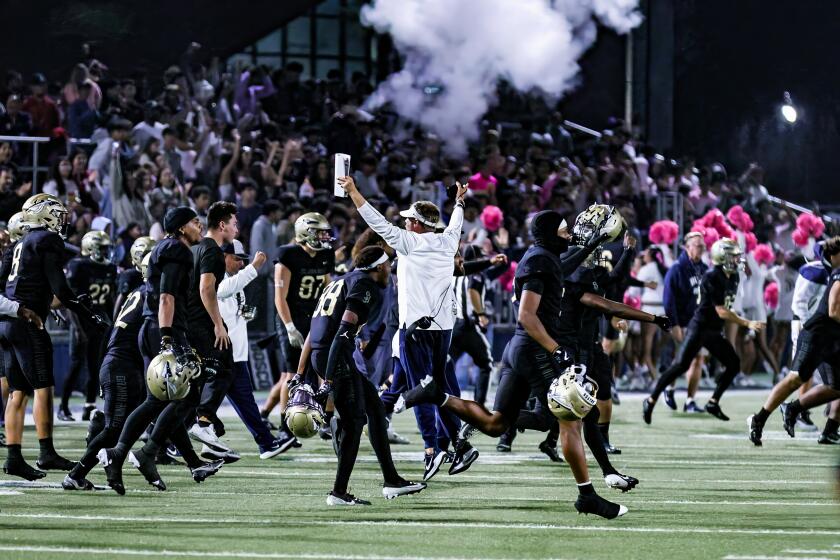Big West Has Plan for Relief : Football: Council to consider adding a lower-level consortium to help its members keep their programs afloat.
Relief for the financially strapped Cal State Fullerton and Cal State Long Beach athletic departments may be on the way.
Next week, the Big West Conference Council will consider a proposal to establish a lower-level, Division I-AA or I-AAA, football consortium to add to its present I-A alignment essentially creating a two-tiered conference for football.
If passed, the measure would allow current Big West members to downgrade football without jeopardizing their conference membership in other sports.
It would also allow schools interested in joining the Big West in football to upgrade their Division II or III programs to Division I without incurring exorbitant costs.
Under NCAA legislation that goes into effect in 1992-93, schools that play Division II or III football but wish to remain Division I in other sports will be required to play Division I football.
Football programs at Cal State Northridge, Sacramento State, UC Santa Barbara, University of San Diego, Santa Clara, St. Mary’s and UC Davis would be affected and are potential Big West consortium members.
For conference schools struggling to survive at the I-A football level, the Big West proposal is an cost-cutting alternative to dropping the sport, which Long Beach nearly did four years ago and Fullerton nearly did last winter.
“This would give schools the option of tailing back their programs instead of eliminating them outright,” said Dennis Farrell, Big West associate commissioner. “I’m not sure if anyone wants to drop down, but this would give them the out if (Division I-A) doesn’t work.”
Fullerton interim Athletic Director Steve DiTolla and Long Beach Athletic Director Corey Johnson said their schools are committed to I-A football, despite heavy budget cuts and poor attendance for home games. But both approved of the proposal.
“It’s always nice to have options,” DiTolla said.
Added Johnson: “It’s not asking us to make a decision now, but it opens the door for the future.”
Farrell said the conference has been discussing the idea for about a year but did not begin serious discussions until June, after Fresno State announced it was leaving for the Western Athletic Conference beginning in the 1992-93 season. Nevada Reno is the leading candidate to replace Fresno State.
By limiting the I-A conference to schools that are fully committed to I-A football, conference officials believe the proposal will stabilize Big West football, prevent future defections and possibly attract other prominent football programs to the conference.
Under the current proposal, conference members will have four years to meet the Division I-A attendance criteria, which states that schools must have a 30,000-seat stadium and average 17,000 fans at home or average 20,000 fans for all games.
“We could possibly attract a San Diego State, Hawaii or even Fresno State back,” Farrell said. “Our attitude is we couldn’t sit back and afford the status quo. If we didn’t do something to improve our football image, we’re vulnerable to having a San Jose State or Nevada Las Vegas leave.”
What level the Big West consortium would play at depends on how the I-AAA football proposal fares at the NCAA convention in January.
If passed, it would create a new level that would permit football scholarships only on a financial-need basis, limit schedules to 10 games and full-time coaching positions to three, and abolish spring practice.
If the I-AAA proposal fails, the Big West consortium could still play at the I-AA level, possibly with a scholarship cap below the I-AA maximum of 75. The Ivy League, for instance, plays I-AA football but awards no scholarships.
“I think the notion of a consortium shows good judgment and a creative approach to football on the West Coast,” San Jose State Athletic Director Tom Brennan said. “It provides criteria for schools that are strong and can support I-A football, and provides the others with another option.”
Farrell said conference administrators have discussed the proposal with Northridge and Sacramento State officials, who have expressed an interest in joining the Big West. He doesn’t believe the conference would have problems attracting six or eight schools for the consortium.
“Any Division I school on the West Coast that plays football lower than I-A would be attracted to this, because they won’t be able to play football at a lower level,” Farrell said.
The Big West Council, which consists of presidents, faculty representatives, athletic directors and senior women’s administrators from the conference’s 10 schools, will discuss the proposal July 31 during meetings in Los Angeles.
Farrell said the council could vote July 31 or Aug. 1, and if the measure is passed, it could go into effect as early as 1992-93.
Although Farrell did not rule out the possibility of new football members participating in other conference sports, he said this proposal deals only with football.
Farrell also said the Big West would reduce the number of conference games required of its I-A schools, thus providing options for schools wishing to play a more attractive nonconference schedule.
“This could accommodate a number of schools--those committed to Division I but not able to play I-A, those who play I-A but want to play a national or regionally strong football schedule but are concerned about the non-revenue sports, and those that need to go to Division I in football,” Farrell said.
Get our high school sports newsletter
Prep Rally is devoted to the SoCal high school sports experience, bringing you scores, stories and a behind-the-scenes look at what makes prep sports so popular.
You may occasionally receive promotional content from the Los Angeles Times.




